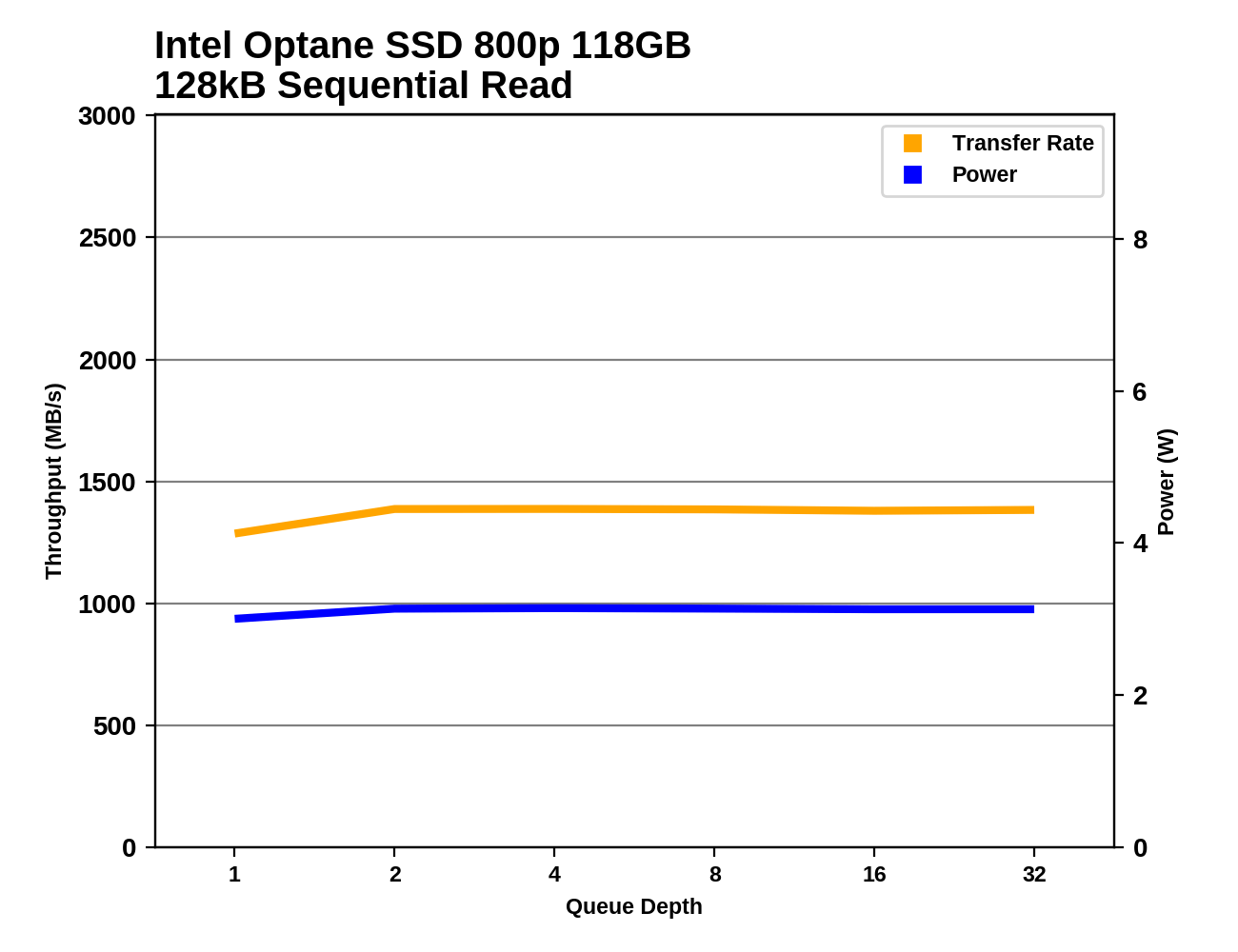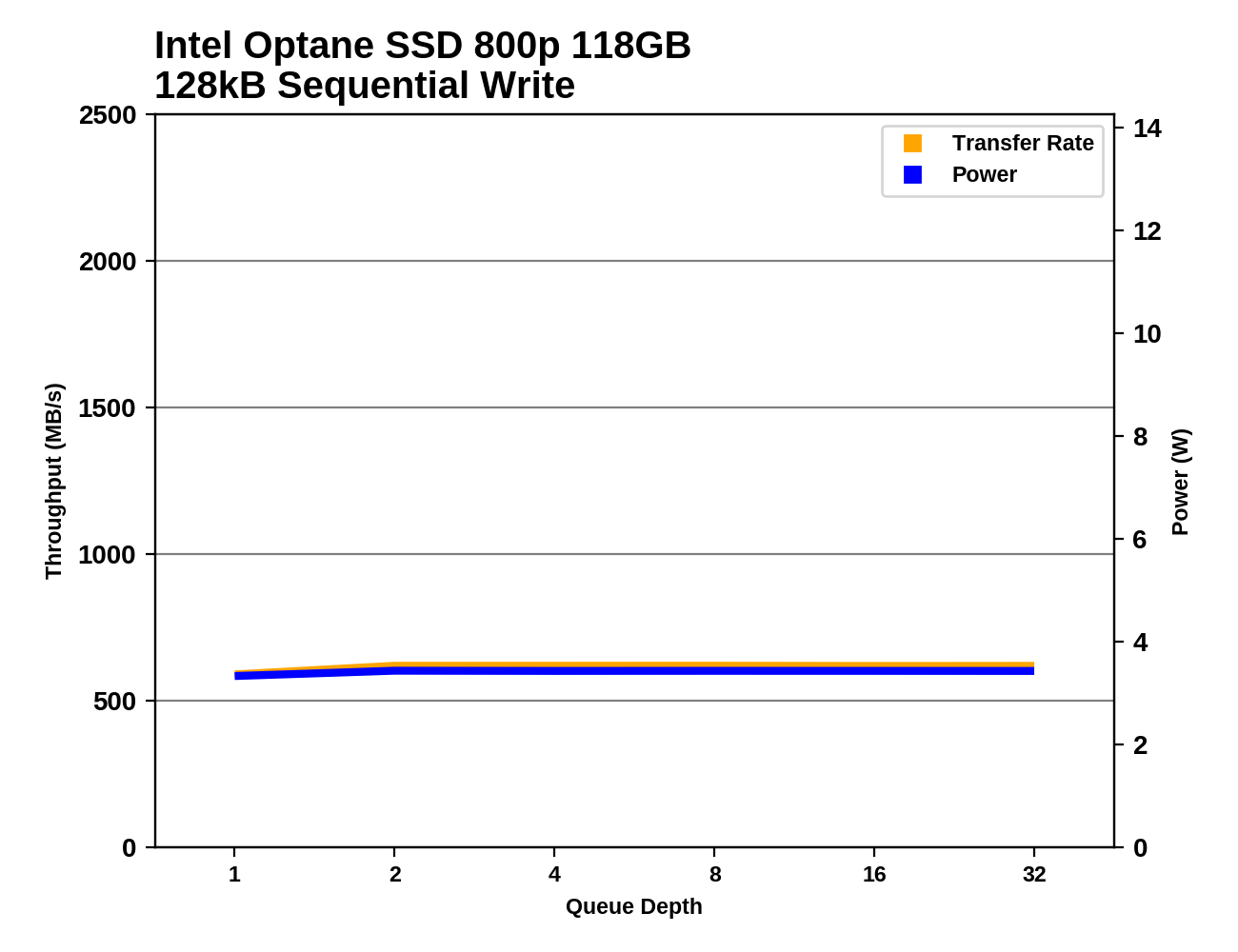The Intel Optane SSD 800p (58GB & 118GB) Review: Almost The Right Size
by Billy Tallis on March 8, 2018 5:15 PM ESTSequential Read Performance
Our first test of sequential read performance uses short bursts of 128MB, issued as 128kB operations with no queuing. The test averages performance across eight bursts for a total of 1GB of data transferred from a drive containing 16GB of data. Between each burst the drive is given enough idle time to keep the overall duty cycle at 20%.

The QD1 burst sequential read performance of the Intel Optane SSD 800p is close to their rated maximum throughput, but they are far behind the 900p and high-end Samsung drives that actually need more than two PCIe lanes.
Our test of sustained sequential reads uses queue depths from 1 to 32, with the performance and power scores computed as the average of QD1, QD2 and QD4. Each queue depth is tested for up to one minute or 32GB transferred, from a drive containing 64GB of data.

On the longer sequential read test, the Samsung NVMe SSDs fall down to the level of the Optane SSD 800p, because the flash-based SSDs are slowed down by some of the data fragmentation left over from the random write test. The Optane SSDs performed those writes as in-place modifications and thus didn't incur any fragmentation. This leaves the Samsung 960 PRO 2TB barely faster than the 800p, while the 900p runs away with its lead.

The Optane SSD 800p has the clear lead in power efficiency, as its second-tier performance comes with far lower power consumption than the top-performing 900p.
 |
|||||||||
There are no big surprises with the queue depth scaling; the 800p's sequential reads are slightly faster at QD2 than QD1, but there's no further improvement beyond that. The 800p is easily staying within its 3.75 W rated maximum power draw.
Sequential Write Performance
Our test of sequential write burst performance is structured identically to the sequential read burst performance test save for the direction of the data transfer. Each burst writes 128MB as 128kB operations issued at QD1, for a total of 1GB of data written to a drive containing 16GB of data.

The burst sequential write speed of the Intel Optane SSD 800p is no better than the low-end flash-based NVMe SSDs. Without any write caching mechanism in the controller, the fundamental nature of 3D XPoint write speeds shows through. The 900p overcomes this by using a 7-channel controller, but that design doesn't fit within the M.2 form factor.
Our test of sustained sequential writes is structured identically to our sustained sequential read test, save for the direction of the data transfers. Queue depths range from 1 to 32 and each queue depth is tested for up to one minute or 32GB, followed by up to one minute of idle time for the drive to cool off and perform garbage collection. The test is confined to a 64GB span of the drive.

The Optane SSD 800p looks better on the sustained sequential write test, as all the TLC-based SSDs run out of SLC cache and slow down dramatically, while the Optane SSDs keep delivering the exact same performance.

Despite their very different sequential write throughput, the Optane SSD 900p and 800p end up with very similar power efficiency on this test. The Samsung NVMe drives are even more efficient, but only the premium MLC-based 960 PRO has a large lead.
 |
|||||||||
Almost all of the drives show no performance scaling with increasing queue depth, as large-block sequential writes can keep all the memory channels busy with only a little bit of buffering. The 900p needs at least two 128kB writes in flight to reach full throughput.










116 Comments
View All Comments
boeush - Thursday, March 8, 2018 - link
P.S. please pardon the "autocorrect"-induced typos... (in the year 2018, still wishing Anandtech would find a way to let us edit our posts...)Calin - Friday, March 9, 2018 - link
Unfortunately, if you already have a computer supporting only 32 GB of RAM, the 200$ for an Intel 800p is peanuts compared to what you would have to pay for a system that supports more than 128GB of RAM - both in costs of mainboard, CPU and especially RAM. I'd venture a guess of a $5,000 entry price (you might pay less for refurbished). It might very possibly be worth it, but it's still a $5k against a $200 investmentThe_Assimilator - Friday, March 9, 2018 - link
Entry-level Intel Xeon + 1U motherboard with 8x DIMM slots = ~$6008x 32GB modules for 256GB RAM total = ~$3,200
So not quite $5k, but still a lot more than $200 :)
mkaibear - Friday, March 9, 2018 - link
...plus a new case, plus a new PSU, plus a UPS...boeush - Saturday, March 10, 2018 - link
Yes, I did mention a lot of $$$...But that's the point: how badly do you really need the extreme random access performance to begin with - above and beyond what a good 1 TB SSD can deliver? Will you even be able to detect the difference? Most workloads are not of such a 'pure' synthetic-like nature, and any decent self-respecting OS will anyway cache your 'hot' files in RAM automatically for you (assuming you have sufficient RAM).
So really, to benefit from such Optane drives (at a cost 4x the equivalent-sized NAND SSD) you'd need to have a very exotic corner-case of a workload - and if you're really into such super-exotic special cases, then likely for you performance trumps cost (and you aren't going to worry so much about +/- a few $thousand here or there...)
jjj - Friday, March 9, 2018 - link
Yeah not impressive at all. They can't reach mainstream price points with higher capacity and that leads to less than stellar perf and a very limiting capacity.To some extent, the conversation should also include investing more in DRAM when building a system but that's hard to quantify.
Intel/Micron need the second gen and decent yields, would be nice if that arrives next year- just saying, it's not like they are providing much info on their plans. Gen 2 was initially scheduled for early 2017 but nobody is talking about roadmaps anymore.
jjj - Friday, March 9, 2018 - link
Just to add something, NAND prices are coming down some and perf per $ is getting better as more folks join the higher perf party. It's not gonna be trivial to compete with NAND in consumer.CheapSushi - Friday, March 9, 2018 - link
Hardware "enthusiasts" have sure become jaded, cynical, grumpy assholes.Reflex - Friday, March 9, 2018 - link
No shit. I think people are confusing their anger at Intel with whether or not this is a good tech advancement. I am wondering if they even are looking at the article I saw. The vast majority of the charts showed Optane products in the lead, power consumption lower, latency lower, etc. Only a few places showed it behind, most around scenarios that are not typical.It is fair to point out its not worth 3x the cost. I'm building a system now, not going with Optane at this price. It is fair to point out that the capacity is not there yet. That is another part of why I'm not using it. Those are valid criticisms. They are also things that are likely to be remedied very soon.
What is not fair is to bash it incessantly for reasons imagined in their own minds (OMG IT DOES NOT HIT THE NUMBERS IN A PAPER ABOUT THE POTENTIAL IN ITS FIRST GEN PRODUCTS!), or ignore the fact that we finally have a potentially great storage alternative to NAND which has a number of limitations we have run up against. This is a great thing.
Adramtech - Saturday, March 10, 2018 - link
Agreed, Reflex. In 2 years Optane Gen 2 is likely going to look a lot better and impress. Criticizing Gen 1 tech is ridiculous.